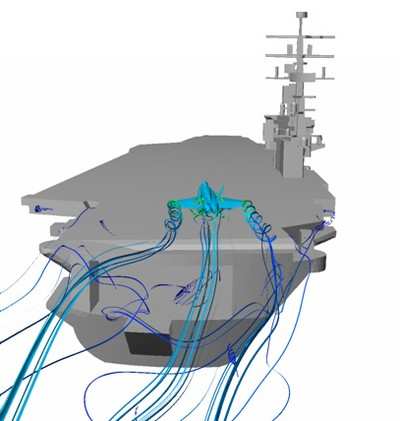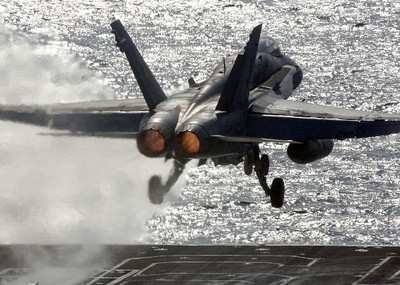Battling The Burble Pays Off In Increased Safety
Aircraft pilots have the third most dangerous job in the world
(behind fishermen and loggers), according to a Bureau of Labor
statistics report for 2005. Naval pilots who must land their
aircraft aboard a moving ship have additional risks associated with
their work.

Susan Polsky and the Airwake Analysis team at Naval Air Station
Patuxent River, MD are working to reduce those risks, making at-sea
landings of H-60s, F/A-18s -- and other Navy aircraft -- safer.
Polsky is an aerospace engineer with the Naval Air Systems Command
(NAVAIR) and leads the team as they work with the Naval Sea Systems
Command to ensure future Navy ships are safe for aviation
operations.
The Airwake Analysis team uses a combination of simulators, wind
tunnels and Computational Fluid Dynamics (CFD – their
computer analysis tool) to determine air flow behind and around a
ship. That airflow, called a “burble” by fixed-wing
pilots, varies in speed and turbulence levels.
"Airwake, or burble, is unavoidable," explained Polsky. "We are
participating in future ship design programs to potentially lessen
that burble since increased turbulence would mean more of a
workload, and an increased risk, for the pilot."

Sid Hatcher is a retired Navy H-60 pilot with 700 small-deck
landings and lots of experience with airwakes. He presently works
as a test pilot for the Naval Air Warfare Center Aircraft
Division’s HX21, the rotary wing test squadron at NAS
Patuxent River.
Recently he has been testing simulations using CFD airwake data
in support of the H-60 Program Office (PMA-299) and the Naval
Aviation Training Systems Program Office (PMA-205).
"Airwake is an important factor in getting an aircraft aboard (a
ship) safely," said Hatcher. "There are controllability challenges
in maintaining a precise position, as well as performance issues
for an aircraft transitioning in and out of the relative
winds."
Previously, the operational capability of an aircraft landing on
a ship was not known until the aircraft landed on the ship for the
first time. Now, ship designers are able to assess potential
geometries on the drawing board for adverse ship airwake effects
before metal is even cut.
One of the ships the team is presently working on is the next
class of carrier (the 21 Class) – specifically, USS Gerald R.
Ford (CVN-78).
"The new carrier has a different superstructure and it’s
in a different place than on existing carriers," said Polsky. The
superstructure houses the command and control functions for the
carrier and the entire battle group.

By using computer modeling, the team can determine where and how
the airwake will flow behind the new ship. Since fixed-wing
aircraft approach for landing from behind a carrier, this is vital
information for pilots.
The team has developed a ship simulation which allows a pilot to
"fly" through new airwake data, obtaining aircraft control surface
activity and other data that help determine how much the airwake
will affect the pilot and the aircraft.
"That data is key to determining any deviations from the old to
the new configurations," explained Polsky.
With that information, the team can develop a training simulator
for pilot orientations in preparation for landing on board CVN-78
and other ships, or to test new aircraft such as the V-22
Osprey.

Lt. Col. Bill Witzig is a US Marine Corps pilot with the V-22
program who has also flown a simulator using the CFD airwake
analysis.
"The value of this effort has enormous potential to improve the
quality of pilot training," said Witzig. "The control inputs needed
close to the flight deck were very representative of those needed
on actual flight decks."
According to Witzig, the Marine Corps’ V-22 training and
readiness manual directs 51% of the total pilot training
requirement be conducted in simulators. "It goes without saying
that flight simulation devices, in this type of a training program,
need to be as realistic as possible."
 Hatcher agrees.
"Especially when coupled with a full motion simulator, the aircraft
response and flight control activity is as close to the real thing
as I’ve seen," he said. "Of course there is nothing better
than using real ships, real aircraft and the real environment. But
sometimes all three are not available. This is especially true when
looking to evaluate shipboard landings in high winds and sea
states. We are discovering CFD airwake modeling is an excellent and
recommended tool for training pilots in shipboard landing as well
as for buildup prior to Dyanamic Interface (shipboard)
testing."
Hatcher agrees.
"Especially when coupled with a full motion simulator, the aircraft
response and flight control activity is as close to the real thing
as I’ve seen," he said. "Of course there is nothing better
than using real ships, real aircraft and the real environment. But
sometimes all three are not available. This is especially true when
looking to evaluate shipboard landings in high winds and sea
states. We are discovering CFD airwake modeling is an excellent and
recommended tool for training pilots in shipboard landing as well
as for buildup prior to Dyanamic Interface (shipboard)
testing."
The Airwake Analysis team also worked with USS Abraham Lincoln
(CVN-72) immediately following the Indian Ocean earthquake/tsunami
in December 2005. The carrier was using helicopters for
humanitarian airlifts, but still needed to continue F/A-18 flight
operations.
Polsky and her team analyzed the level of jet wash (air expelled
from a jet engine) during a catapult launch and determined that the
helicopters could safely land and take off using a platform on the
other side of the super structure. Their work will impact most of
the other Navy carriers as ship deck markings are changed and as
the temporary Interim Flight Clearance becomes permanent, expanding
operational envelopes beyond their previous capacity.
The team has also performed a general airflow evaluation on the
latest destroyer design – the DDG 1000. They used the H-60
helicopter as their model for the evaluation of the Zumwalt Class
Destroyer. The results of the team’s analysis and testing are
being utilized by the program office in the design efforts for DDG
1000. The team's efforts have provided confidence to the DDG 1000
team that the unique deckhouse design does not adversely effect
helicopter operations on the flight deck as the analyzed air flow
is shown to be within acceptable operation limits for the H-60.
"Our job was to look at the operational envelope for the H-60 on
the new ship and determine if it’s acceptable or unacceptable
relative to current destroyers," explained Polsky. "We used CFD to
predict the airflow around the ship and the results were provided
to the program office to help identify any risk to aviation
associated with the unconventional topside design."
"By getting it right the first time, the need for expensive
modifications to the ship geometry are averted," said Polsky, "and
the Fleet is provided with the ship-aircraft system that gets the
job done in as wide a range of environmental conditions as
possible."
Although influencing ship design in the earliest stages allows
Polsky and her team to help enlarge the operational envelope of
Navy ships, they are especially pleased to be increasing the safety
of the pilots who land their aircraft aboard those ships.
"I’m thrilled that we’ve been able to positively
impact the Fleet by reducing the risk of operating aircraft –
both fixed and rotary wing," said Polsky.
(ANN thanks Vicky Falcón, NAVAIR Public Affairs
Office, for this report.)
 ANN's Daily Aero-Linx (04.16.24)
ANN's Daily Aero-Linx (04.16.24) Aero-News: Quote of the Day (04.16.24)
Aero-News: Quote of the Day (04.16.24) Airborne 04.10.24: SnF24!, A50 Heritage Reveal, HeliCycle!, Montaer MC-01
Airborne 04.10.24: SnF24!, A50 Heritage Reveal, HeliCycle!, Montaer MC-01 Airborne 04.12.24: SnF24!, G100UL Is Here, Holy Micro, Plane Tags
Airborne 04.12.24: SnF24!, G100UL Is Here, Holy Micro, Plane Tags Airborne-Flight Training 04.17.24: Feds Need Controllers, Spirit Delay, Redbird
Airborne-Flight Training 04.17.24: Feds Need Controllers, Spirit Delay, Redbird







